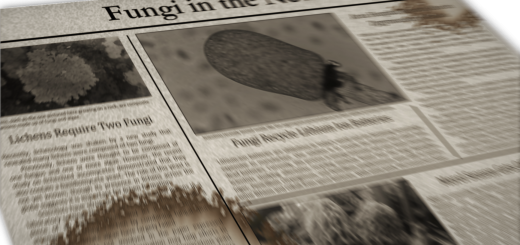#019: Apiosporina morbosa, Black Knot of Cherry [Archived]
Note: this is an archived post. You can view the current version of this post here.
And now for something completely different: identifying trees from a long way away. If you’ve ever tried to identify deciduous trees in the winter, you know how hard it is to identify a tree based on its bark. However, thanks to the fungus Apiosporina morbosa, identifying cherry trees in winter becomes a walk in the park. Apiosporina morbosa is an ascomycete that parasitizes cherry and plum trees. Commonly known as “black knot,” the fungus forms black, dry, cracked, irregular swellings on branches which grow to surround the branch. According to Michael Kuo, these knots look like “dried cat poop on a stick.”* Although this is not the most attractive-looking fungus, it is very helpful for identifying cherry trees from hundreds of feet away, especially in winter when the knots are not hidden by leaves.
Black knot is more common in cherry and plum orchards, where many susceptible trees are found in close proximity to each other. Because of this environment, black knot can be a significant disease of cultivated cherry and plum trees. Wild trees are more spread out and therefore contract the disease less frequently. The fungus releases spores beginning in spring, coinciding with the start of the growing season for its hosts. The trees’ new shoots are most susceptible to infection, although the spores can also infect damaged tissue. Initial symptoms of infection are difficult to spot, and the fungus is already well-established by the time the knots begin to form (during the second summer after infection). The knots are actually galls formed by the tree to try and contain the fungus. The fungus-plant interaction results in tumor-like growth of the plant cells to form a gall. The fungus produces spores on the surface of the gall while spreading its mycelium through the gall and through the branch itself. The spreading mycelium can cause new galls to form some distance away from the original infection site. Older portions of the knots break down and become home to boring beetles (as in beetles that bore holes). Infected branches become stunted and may eventually die off. The disease also weakens the tree and reduces is fruit yield. The weakened trees eventually die from black knot or a combination of diseases. The two best ways to mitigate the effects of black knot are by planting disease-resistant trees and by removing the knots themselves in the winter before they begin producing spores.
See Further:
* http://www.mushroomexpert.com/apiosporina_morbosa.html
http://www.hiltonpond.org/ThisWeek031201.html
http://www.apsnet.org/edcenter/intropp/lessons/fungi/ascomycetes/pages/blackknot.aspx








![#011: Characteristics of Kingdom Fungi [Archived]](https://www.fungusfactfriday.com/wp-content/themes/hueman/assets/front/img/thumb-small-empty.png)
